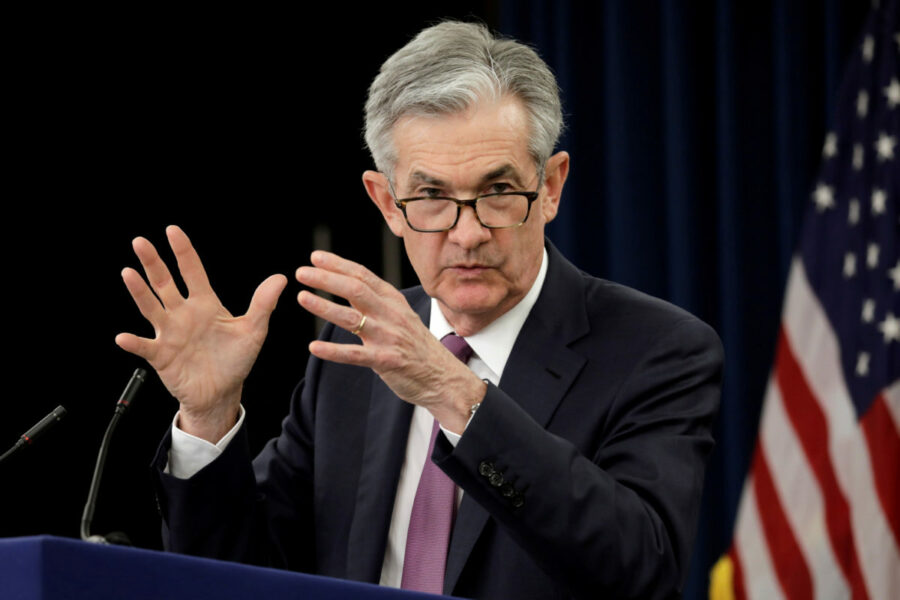September 19, 2024 Federal Reserve’s Aggressive Move Hints At Bold Economic Strategy
September 11, 2024 Top Stocks For Smart Investment Choices
September 8, 2024 S&P 500 In Freefall: Is This The End Of The Bull Market?
September 6, 2024 Jobs Report Spotlight As Fed Weighs Rate Cut Decision
Tesla: 4680 Battery On Cybertrucks Could Be A Big Deal
Selling Amazon On Recession Risks (Downgrade)
Amazon: See The Company From A Different Perspective
April 23, 2024 Maximizing Profits: When is the Right Time to Sell Your Business?
April 12, 2024 Improve Your Financial Status: A How-To Guide
April 12, 2024 How ZIM Integrated Container Tracking is Revolutionizing Global Trade
March 15, 2024 6 Best Growth Stocks To Buy Now According to Metatrader 5
Federal Reserve’s Aggressive Move Hints At Bold Economic Strategy
September 19, 2024

Federal Reserve Board Chairman Jerome Powell speaks at his news conference
The Federal Reserve made a bold step with a 50 basis point rate cut. This post will show how this move aims to keep the job market stable and inflation under control. Keep reading to learn more.
Key Takeaways
- The Federal Reserve cut the benchmark interest rate by 50 basis points, aiming to stimulate economic activity. This move seeks to make borrowing cheaper for both individuals and businesses, encouraging spending and investment.
- An overwhelming majority of the Federal Open Market Committee (FOMC) members voted 11-1 in favor of cutting rates. This decision reflects a strong consensus among committee members on the need to address uncertain economic times with decisive action.
- Fed Chair Jerome Powell highlighted that this decision aims at fostering a robust labor market while also trying to bring inflation back to its 2% target. These steps are part of their strategy to achieve a balanced economy through careful planning.
- There’s an expectation of further rate cuts as indicated by central bank officials, showing their readiness to adjust policies in response to changing economic conditions. They aim for what is known as a “soft landing” by stabilizing employment without provoking high inflation or unemployment.
- Following the rate cut, markets reacted positively with indications of increased investor confidence. This demonstrates how central bank actions can have immediate effects on stock exchanges and currency markets, influencing overall economic sentiment.
Federal Reserve’s Aggressive Move
The Federal Reserve made a bold decision by cutting the benchmark interest rate by half a percent. This move showed their strong resolve to shape the future economic path, with most members voting in favor.
Implementation of a significant 50 basis point rate cut
Central bankers opted to diminish borrowing costs substantially by 50 basis points. This action signifies the onset of a novel stage of monetary relaxation. It’s a significant increment in making it cheap for individuals and businesses to acquire money.
Depressed interest rates might assist in escalating economic activity by prompting spending and investment.
This choice fosters potent labor market states and pursues to restore inflation to its 2% aim, stated Jerome Powell, Chair of the Federal Reserve.
Following this rate reduction, anyone, from homeowners considering refinancing mortgages to enterprises aiming for loans for expansion, will encounter less expense in borrowing. It additionally impacts savings accounts, but the primary emphasis remains on accelerating economic expansion.
Overwhelming support with an 11-1 vote among committee members

The Federal Open Market Committee (FOMC) showed strong unity in their recent decision to cut the federal funds rate. With an 11-1 vote, nearly all members agreed on this significant step toward influencing the American economy’s direction.
This rare consensus highlights the committee’s commitment to steering the US through uncertain economic times.
One member voted against the decision, suggesting some debate over the best path forward for monetary policy and its impact on inflation, mortgage rates, and savings investments. Yet, the overwhelming majority signals a solid stance from these key players in managing economic downturns and aiming for sustainable growth.
Expectation of further rate cuts in upcoming meetings
Investors are closely monitoring the Federal Reserve’s forthcoming actions, given the small majority of 10 out of 19 officials predicting additional rate reductions. These expected adjustments could occur in the year’s final meetings, set for November and December.
This strategy intends to manage potential economic slowdown risks while promoting growth-friendly conditions.
These continued policy rate changes might act as protection against excessive inflation and unemployment, key issues affecting savings and investments across the U.S. economy. With these measures, the Fed shows its dedication to guiding the economy to stability, giving priority to both labor market wellbeing and stable price levels amid ongoing uncertainties.
Strategy and Goals
The Federal Reserve aims to achieve a balanced economy through careful plans. They focus on stabilizing jobs and controlling prices rises, keeping economic health in their sights.
Aim for a “soft landing” while stabilizing the labor market and managing inflation
To achieve a “soft landing,” Federal Reserve strategies focus on keeping the labor market stable and controlling inflation near their 2% goal. This approach helps prevent joblessness from rising while also ensuring prices do not skyrocket, making everyday items like groceries, auto loans, and housing more affordable.
By adjusting interest rates carefully, the Fed tries to cool down high inflation without triggering a recession that could lead to widespread unemployment.
Next, Fed Chair Jerome Powell emphasizes the commitment to maintaining economic strength across sectors, including jobs in technology and manufacturing. This balance between growth and stability signals careful planning in bank lending practices and monitoring of financial markets to support continual economic development.
Moving forward, insights into market reactions offer a glimpse into how these strategies might play out in real-world scenarios.
Commitment to maintaining economic strength, as highlighted by Fed Chair Jerome Powell
Fed Chair Jerome Powell reaffirmed the Federal Reserve’s commitment to preserving US economic strength. He expressed trust in the recent policy alterations, intended to smartly handle economical hitches.
Powell is confident that these measures will foster economic development and steadiness.
He discussed a proactive method to deal directly with any financial disturbances. This tactic indicates a profound dedication to steer the country in the direction of sustained wealth.
The Federal Reserve anticipates further steps if necessary, continuously focusing on upholding a strong labor market and managing inflation. With such practices, Powell offers investors assurance of the Fed’s preparedness to uphold economic strength in the face of worldwide obstacles.
Market Reaction and Implications
Following the Federal Reserve’s decision, traders and investors quickly adjusted their portfolios. This move reflected in changes across stock exchanges and currency dealings.
Initial market expectations and reactions
Before the Federal Reserve announced its rate cut, investors showed mixed feelings. The latest Wall Street Bets poll had many thinking the Fed would act with caution. Yet, the S&P 500 almost hit record highs right before settling with slight gains by day’s end.
Overnight, futures markets lit up, hinting at a big rally to come.
This move by the Fed signals a bold strategy that could shape our economic future, says an economist from Goldman Sachs.
Investors kept an eye on these shifts, ready to adjust their strategies in stock and currency markets. They knew such actions by central banks often lead to significant changes in economic conditions and labor market outlooks.
Insights from the Fed’s “dot plot” in the Summary of Economic Projections
The Federal Reserve’s Summary of Economic Projections offers vital information, illustrating the anticipated future of the Fed funds rate. An update presents meaningful alterations, with anticipation of a 3.4% Fed funds rate by the end of the coming year, down from the present range of 4.75% to 5%.
The June forecast was at 4.1%. This alteration indicates the Federal Reserve’s reassessment of its outlook. The change reflects the Federal Reserve’s actions to amend previous underestimations regarding the persistence of elevated inflation in 2021.
The following is an organized presentation of these details:
| Projection | Current Rate | Past Estimate (June) | Revised Estimate |
|---|---|---|---|
| Fed Funds Rate by Year-End Following Year | 4.75% to 5% | 4.1% | 3.4% |
These figures indicate an intentional policy shift. The Federal Reserve’s goal is a stable employment market and controlled inflation—a challenging equilibrium requiring deliberate policy and action. The “dot plot” is a tool to clearify the Federal Reserve’s rate outlook to investors, informing their investment decisions.
The Federal Reserve aims to circumvent abrupt economic fluctuations. The drop in the predicted Fed funds rate signals a shift to a more accommodating monetary stance, possibly aiding in sustaining economic expansion while managing inflation. This information is key for investors who adapt their investment approaches in response to forecasted interest rate movements.
Conclusion
The Federal Reserve’s recent decision to decrease rates demonstrates a decisive strategy for directing the US economy. Lowering interest rates by 50 basis points shows their commitment to promoting economic expansion and controlling inflation.
With significant support from committee votes and considering more reductions, their strategy targets a stable market and employment situation. Market participants are aware, modifying their strategies to adapt to the shifts that this decision created in stock markets and financial predictions.
This assertive policy signifies a crucial change as officials maneuver through economic difficulties, relying on endurance and flexibility to ensure growth.
FAQs
1. What does the Federal Reserve’s aggressive move imply about its economic strategy?
The Federal Reserve’s bold maneuver signals a proactive approach to influencing the US economy. This may involve leveraging monetary easing techniques or adopting a tight money policy, depending on economic data and growth projections.
2. How might this strategy impact the stock market and global currency values?
Economic policies enacted by the Federal Reserve often ripple through financial markets, affecting everything from stocks to forex trading rates for currencies like the Euro, Yen, and US Dollar. The exact impact would depend on specifics of their strategy.
3. Could these actions affect housing affordability or exacerbate a potential housing bubble?
Yes, changes in interest rates can influence credit availability for home loans which directly impacts housing supply and affordability. It could also potentially fuel a housing bubble if not managed properly.
4. How are economists interpreting this move by the Federal Reserve?
While perspectives among economists vary widely based on their macroeconomic views, most agree that such an aggressive stance reflects urgency to steer clear of recessions or mitigate any impending financial crisis.
5. In what way will this strategic shift touch upon sectors like corporate finance and proptech?
Corporate finance might see an alteration in profits due to fluctuations in bonds’ value and credit conditions influenced by Fed’s policies. Proptech could be affected too as it closely ties with real estate trends impacted by shifts in affordable social housing provision.
6. Lastly, how might consumers feel these effects personally?
Consumers may experience changes in areas such as credit card interest rates or student loan terms because of modified federal reserve strategies impacting broader debt structures within our economy.















